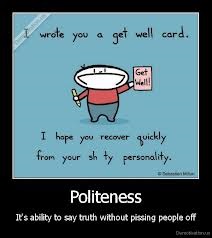
At the core of the politeness theory of Penelope Brown and Stephen Levinson, is that in everyday life we design messages that protect face and achieve other goals. In other words this theoretical perspective focuses on polite interaction in communication. Brown and Levinson maintain that politeness is often a goal in communication because it is a culturally universal value. In all cultures politeness, though expressed in different ways, is key.
Key Terms Of Politeness Theory
Under the politeness theory all people have face needs which is a need to be appreciated and to be protected and in through communication we strive to meet those need and when we have not done so accurately we try to make amends for this. The desire to be appreciated, respected and approved is called positive face and the act of meeting this need is referred to as positive politeness. An example of positive politeness would be offering a compliment, being respectful or showing concern.
Whereas the desire to be free from intrusion and imposition/ bother is known as negative face. Being indirect or apologetic to avoid intrusion, hedging or addressing the person in a superior manner i.e “sir or mam” is showing negative politeness. This is done to protect the other person when face needs are threatened. So if you stop someone on the street to ask for direction and they seem to be in a hurry you may say “I’m sorry to bother you but could you tell me how to get to Cave Shepherd?”
In communication we may commit face threatening acts or FTAs and we especially run the risk of doing this when making request. FTAs occur when we behave in a way that threatens positive or negative face needs and it might seem that you are not being thoughtful or even rude. FTAs are a part of communication and everyday because we all ask for favours and at some time this favour may inconvenience the other person.
FTAs in Action
This weekend I plan to go out but I will need my own transportation to do so. The only available car is my mother’s and her allowing me to drive it will not come easy.She is in the living room reading the newspaper, what do I do?
1. I could just say, “Mum I want to borrow your car” but that would be delivering the FTA with neither positive or negative politeness. Not only would I seem impolite but I also might not get the car.
2. I could say, “Mummy I would really appreciate it if you allow me to drive your car, you know you are the coolest mom ever.” By doing this I deliver the FTAs with a form of positive politeness; a compliment. This may not work as my mom could perceive this as me “buttering her up” and think I am being disingenuous.
3. I could also try, “Mummy I know that you are a little busy now but could I have your attention for a moment? I would really like it if you would let me use your car on Saturday night.” This approach might very well encourage her to let me use her car. The combination of the FTA with negative politeness is a lot less face threatening than the other above. (If only I knew this instead of “pretty please with a cherry on top” I may have gotten a lot of things)
4. Another option would be to say, “I wonder how I am going to get to that party on Saturday night?” “Maybe I should get a taxi?” just within earshot of mother while talking to a friend on the telephone. I am hoping she gets the hint and says, “Why don’t you just take my car?” However if my mom says you can’t use my car, I have to go by your aunt,” I can always reply, Oh I wasn’t asking to borrow your car”, “I was just thinking out loud.” With this “off the record” FTA which allows me to be indirect and ambiguous, I can deny that I have made any kind of request.
5. I could also not deliver any FTA at all. in other words just not ask my mom to borrow her car.
While FTAs are a part of communication and do not necessarily need to be avoided the way in which we mitigate them is influenced by other factors. Nevertheless, for Brown and Levinson the way we decide to go about it can be determined by this formula: Wx=D(S,H) + P(H,S) + Rx. Translation The amount of work one puts into being polite depends on the social distance between the speaker and the hearer, plus the power of the hearer over the speaker, plus the risk of hurting the other person. Upon see this it became clear to me why, in an interview with the Minister of Education the journalist shied away from the tough questions and in essence allowed the minister to “steam roll” her and take over the interview. The journalist may not have wanted to appear rude by saying something like “You know that you didn’t answer this question?’ Or she could be reacting to the social distance between them as they are not friends or colleagues she may not know how to press him for answers without committing a FTA. It may also be due to the fact that he is clearly in a more authoritative position than her as he is minister and she is a journalist. (In our country he is essentially her boss as the government subsidizes this news station).



Recent Comments